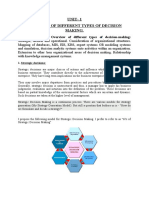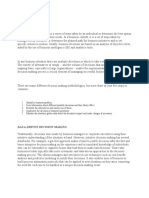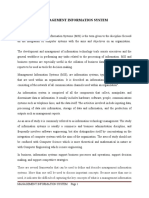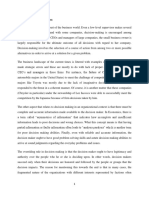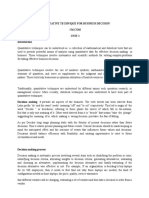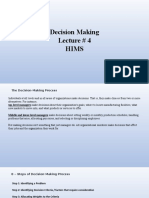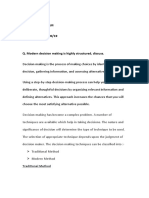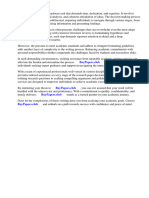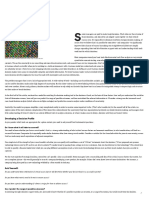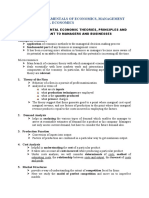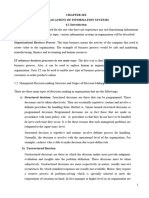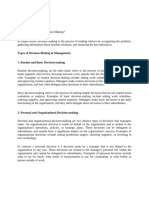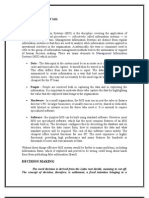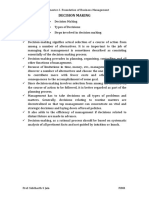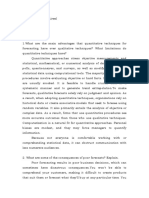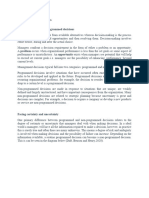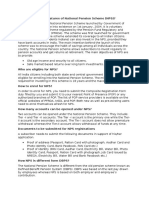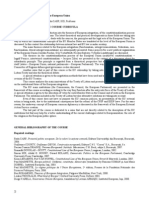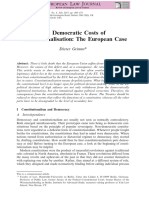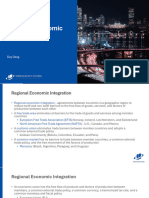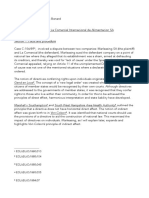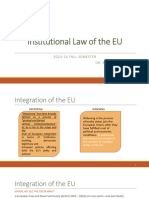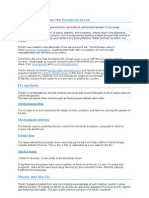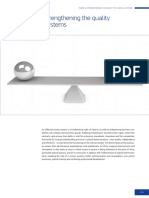0 ratings0% found this document useful (0 votes)
63 viewsQuestion 1: Write A Note On Decision Making in Management. How One Will Take Decision Under Risk and Uncertainty
Question 1: Write A Note On Decision Making in Management. How One Will Take Decision Under Risk and Uncertainty
Uploaded by
Avinash IngoleDecision-making is crucial for businesses and involves gathering good information, consulting others, and being open to changing one's mind. Managers need training and a supportive environment to make good decisions under risk and uncertainty. Decisions happen at different levels from strategic decisions made by boards of directors to operational decisions by employees. There are programmed routine decisions and non-programmed non-routine decisions. Constraints on decision-making include availability of finances, existing business policies, employees' abilities, legislation, and competitors' actions. Quality decision-making involves manager training, good information analysis, experience, and considering human factors.
Copyright:
© All Rights Reserved
Available Formats
Download as ODT, PDF, TXT or read online from Scribd
Question 1: Write A Note On Decision Making in Management. How One Will Take Decision Under Risk and Uncertainty
Question 1: Write A Note On Decision Making in Management. How One Will Take Decision Under Risk and Uncertainty
Uploaded by
Avinash Ingole0 ratings0% found this document useful (0 votes)
63 views14 pagesDecision-making is crucial for businesses and involves gathering good information, consulting others, and being open to changing one's mind. Managers need training and a supportive environment to make good decisions under risk and uncertainty. Decisions happen at different levels from strategic decisions made by boards of directors to operational decisions by employees. There are programmed routine decisions and non-programmed non-routine decisions. Constraints on decision-making include availability of finances, existing business policies, employees' abilities, legislation, and competitors' actions. Quality decision-making involves manager training, good information analysis, experience, and considering human factors.
Original Title
Untitled Melody 225487
Copyright
© © All Rights Reserved
Available Formats
ODT, PDF, TXT or read online from Scribd
Share this document
Did you find this document useful?
Is this content inappropriate?
Decision-making is crucial for businesses and involves gathering good information, consulting others, and being open to changing one's mind. Managers need training and a supportive environment to make good decisions under risk and uncertainty. Decisions happen at different levels from strategic decisions made by boards of directors to operational decisions by employees. There are programmed routine decisions and non-programmed non-routine decisions. Constraints on decision-making include availability of finances, existing business policies, employees' abilities, legislation, and competitors' actions. Quality decision-making involves manager training, good information analysis, experience, and considering human factors.
Copyright:
© All Rights Reserved
Available Formats
Download as ODT, PDF, TXT or read online from Scribd
Download as odt, pdf, or txt
0 ratings0% found this document useful (0 votes)
63 views14 pagesQuestion 1: Write A Note On Decision Making in Management. How One Will Take Decision Under Risk and Uncertainty
Question 1: Write A Note On Decision Making in Management. How One Will Take Decision Under Risk and Uncertainty
Uploaded by
Avinash IngoleDecision-making is crucial for businesses and involves gathering good information, consulting others, and being open to changing one's mind. Managers need training and a supportive environment to make good decisions under risk and uncertainty. Decisions happen at different levels from strategic decisions made by boards of directors to operational decisions by employees. There are programmed routine decisions and non-programmed non-routine decisions. Constraints on decision-making include availability of finances, existing business policies, employees' abilities, legislation, and competitors' actions. Quality decision-making involves manager training, good information analysis, experience, and considering human factors.
Copyright:
© All Rights Reserved
Available Formats
Download as ODT, PDF, TXT or read online from Scribd
Download as odt, pdf, or txt
You are on page 1of 14
Question 1: Write a note on decision making in management.
How one will
take decision under risk and uncertainty.
Answer:
Decision-making is a crucial part of good business. The question then is how
is a good decision made?
One part of the answer is good information, and experience in interpreting
information. Consultation ie seeking the views and expertise of other people
also helps, as does the ability to admit one was wrong and change ones
mind. There are also aids to decision-making, various techniques which help
to make information clearer and better analysed, and to add numerical and
objective precision to decision-making (where appropriate) to reduce the
amount of subjectivity.
Managers can be trained to make better decisions. They also need a
supportive environment where they wont be unfairly criticised for making
wrong decisions (as we all do sometimes) and will receive proper support
from their colleague and superiors. A climate of criticism and fear stifles risktaking
and creativity; managers will respond by playing it safe to minimise
the risk of criticism which diminishes the business effectiveness in
responding to market changes. It may also mean managers spend too much
time trying to pass the blame around rather than getting on with running the
business.
Decision-making increasingly happens at all levels of a business. The Board
of Directors may make the grand strategic decisions about investment and
direction of future growth, and managers may make the more tactical
decisions about how their own department may contribute most effectively to
the overall business objectives. But quite ordinary employees are
increasingly expected to make decisions about the conduct of their own
tasks, responses to customers and improvements to business practice. This
needs careful recruitment and selection, good training, and enlightened
management.
Types of Business Decisions
1. Programmed Decisions These are standard decisions which always
follow the same routine. As such, they can be written down into a series of
fixed steps which anyone can follow. They could even be written as computer
program
2. Non-Programmed Decisions. These are non-standard and non-routine.
Each decision is not quite the same as any previous decision.
3. Strategic Decisions. These affect the long-term direction of the business
eg whether to take over Company A or Company B
4. Tactical Decisions. These are medium-term decisions about how to
implement strategy eg what kind of marketing to have, or how many extra
staff to recruit
5. Operational Decisions. These are short-term decisions (also called
administrative decisions) about how to implement the tactics eg which firm
to use to make deliveries.
Figure 1: Levels of Decision-Making
Figure 2: The Decision-Making Process
The model in Figure 2 above is a normative model, because it illustrates
how a good decision ought to be made. Business Studies also uses positive
models which simply aim to illustrate how decisions are, in fact, made in
businesses without commenting on whether they are good or bad.
Linear programming models help to explore maximising or minimising
constraints eg one can program a computer with information that establishes
parameters for minimising costs subject to certain situations and information
about those situations.
Spread-sheets are widely used for what if simulations. A very large
spread-sheet can be used to hold all the known information about, say,
pricing and the effects of pricing on profits. The different pricing assumptions
can be fed into the spread-sheet modelling different pricing strategies. This
is a lot quicker and an awful lot cheaper than actually changing prices to see
what happens. On the other hand, a spread-sheet is only as good as the
information put into it and no spread-sheet can fully reflect the real world.
But it is very useful management information to know what might happen to
profits what if a skimming strategy, or a penetration strategy were used for
pricing.
The computer does not take decisions; managers do. But it helps managers
to have quick and reliable quantitative information about the business as it is
and the business as it might be in different sets of circumstances. There is,
however, a lot of research into expert systems which aim to replicate the
way real people (doctors, lawyers, managers, and the like) take decisions.
The aim is that computers can, one day, take decisions, or at least
programmed decisions (see above). For example, an expedition could carry
an expert medical system on a lap-top to deal with any medical emergencies
even though the nearest doctor is thousands of miles away. Already it is
possible, in the US, to put a credit card into a hole-in-the-wall machine and
get basic legal advice about basic and standard legal problems.
Constraints on Decision-Making
Internal Constraints
These are constraints that come from within the business itself.
- Availability of finance. Certain decisions will be rejected because they
cost too much
- Existing Business Policy. It is not always practical to re-write business
policy to accommodate one decision
- Peoples abilities and feelings. A decision cannot be taken if it assumes
higher skills than employees actually have, or if the decision is so unpopular
no-one will work properly on it.
External Constraints
These come from the business environment outside the business.
- National & EU legislation
- Competitors behaviour, and their likely response to decisions your
business makes
- Lack of technology
- Economic climate
Quality of Decision-Making
Some managers and businesses make better decisions than others. Good
decision-making comes from:1. Training of managers in decision-making skills. See Developing
Managers
2. Good information in the first place.
3. Management skills in analysing information and handling its
shortcomings.
4. Experience and natural ability in decision-making.
5. Risk and attitudes to risk.
6. Human factors. People are people. Emotional responses come
before rational responses, and it is very difficult to get people to make
rational decisions about things they feel very strongly about. Rivalries
and vested interests also come into it. People simply take different
views on the same facts, and people also simply make mistakes. Question 1: Write a
note on decision making in management. How one will
take decision under risk and uncertainty.
Answer:
Decision-making is a crucial part of good business. The question then is how
is a good decision made?
One part of the answer is good information, and experience in interpreting
information. Consultation ie seeking the views and expertise of other people
also helps, as does the ability to admit one was wrong and change ones
mind. There are also aids to decision-making, various techniques which help
to make information clearer and better analysed, and to add numerical and
objective precision to decision-making (where appropriate) to reduce the
amount of subjectivity.
Managers can be trained to make better decisions. They also need a
supportive environment where they wont be unfairly criticised for making
wrong decisions (as we all do sometimes) and will receive proper support
from their colleague and superiors. A climate of criticism and fear stifles risktaking
and creativity; managers will respond by playing it safe to minimise
the risk of criticism which diminishes the business effectiveness in
responding to market changes. It may also mean managers spend too much
time trying to pass the blame around rather than getting on with running the
business.
Decision-making increasingly happens at all levels of a business. The Board
of Directors may make the grand strategic decisions about investment and
direction of future growth, and managers may make the more tactical
decisions about how their own department may contribute most effectively to
the overall business objectives. But quite ordinary employees are
increasingly expected to make decisions about the conduct of their own
tasks, responses to customers and improvements to business practice. This
needs careful recruitment and selection, good training, and enlightened
management.
Types of Business Decisions
1. Programmed Decisions These are standard decisions which always
follow the same routine. As such, they can be written down into a series of
fixed steps which anyone can follow. They could even be written as computer
program
2. Non-Programmed Decisions. These are non-standard and non-routine.
Each decision is not quite the same as any previous decision.
3. Strategic Decisions. These affect the long-term direction of the business
eg whether to take over Company A or Company B
4. Tactical Decisions. These are medium-term decisions about how to
implement strategy eg what kind of marketing to have, or how many extra
staff to recruit
5. Operational Decisions. These are short-term decisions (also called
administrative decisions) about how to implement the tactics eg which firm
to use to make deliveries.
Figure 1: Levels of Decision-Making
Figure 2: The Decision-Making Process
The model in Figure 2 above is a normative model, because it illustrates
how a good decision ought to be made. Business Studies also uses positive
models which simply aim to illustrate how decisions are, in fact, made in
businesses without commenting on whether they are good or bad.
Linear programming models help to explore maximising or minimising
constraints eg one can program a computer with information that establishes
parameters for minimising costs subject to certain situations and information
about those situations.
Spread-sheets are widely used for what if simulations. A very large
spread-sheet can be used to hold all the known information about, say,
pricing and the effects of pricing on profits. The different pricing assumptions
can be fed into the spread-sheet modelling different pricing strategies. This
is a lot quicker and an awful lot cheaper than actually changing prices to see
what happens. On the other hand, a spread-sheet is only as good as the
information put into it and no spread-sheet can fully reflect the real world.
But it is very useful management information to know what might happen to
profits what if a skimming strategy, or a penetration strategy were used for
pricing.
The computer does not take decisions; managers do. But it helps managers
to have quick and reliable quantitative information about the business as it is
and the business as it might be in different sets of circumstances. There is,
however, a lot of research into expert systems which aim to replicate the
way real people (doctors, lawyers, managers, and the like) take decisions.
The aim is that computers can, one day, take decisions, or at least
programmed decisions (see above). For example, an expedition could carry
an expert medical system on a lap-top to deal with any medical emergencies
even though the nearest doctor is thousands of miles away. Already it is
possible, in the US, to put a credit card into a hole-in-the-wall machine and
get basic legal advice about basic and standard legal problems.
Constraints on Decision-Making
Internal Constraints
These are constraints that come from within the business itself.
- Availability of finance. Certain decisions will be rejected because they
cost too much
- Existing Business Policy. It is not always practical to re-write business
policy to accommodate one decision
- Peoples abilities and feelings. A decision cannot be taken if it assumes
higher skills than employees actually have, or if the decision is so unpopular
no-one will work properly on it.
External Constraints
These come from the business environment outside the business.
- National & EU legislation
- Competitors behaviour, and their likely response to decisions your
business makes
- Lack of technology
- Economic climate
Quality of Decision-Making
Some managers and businesses make better decisions than others. Good
decision-making comes from:1. Training of managers in decision-making skills. See Developing
Managers
2. Good information in the first place.
3. Management skills in analysing information and handling its
shortcomings.
4. Experience and natural ability in decision-making.
5. Risk and attitudes to risk.
6. Human factors. People are people. Emotional responses come
before rational responses, and it is very difficult to get people to make
rational decisions about things they feel very strongly about. Rivalries
and vested interests also come into it. People simply take different
views on the same facts, and people also simply make mistakes. Question 1: Write a
note on decision making in management. How one will
take decision under risk and uncertainty.
Answer:
Decision-making is a crucial part of good business. The question then is how
is a good decision made?
One part of the answer is good information, and experience in interpreting
information. Consultation ie seeking the views and expertise of other people
also helps, as does the ability to admit one was wrong and change ones
mind. There are also aids to decision-making, various techniques which help
to make information clearer and better analysed, and to add numerical and
objective precision to decision-making (where appropriate) to reduce the
amount of subjectivity.
Managers can be trained to make better decisions. They also need a
supportive environment where they wont be unfairly criticised for making
wrong decisions (as we all do sometimes) and will receive proper support
from their colleague and superiors. A climate of criticism and fear stifles risktaking
and creativity; managers will respond by playing it safe to minimise
the risk of criticism which diminishes the business effectiveness in
responding to market changes. It may also mean managers spend too much
time trying to pass the blame around rather than getting on with running the
business.
Decision-making increasingly happens at all levels of a business. The Board
of Directors may make the grand strategic decisions about investment and
direction of future growth, and managers may make the more tactical
decisions about how their own department may contribute most effectively to
the overall business objectives. But quite ordinary employees are
increasingly expected to make decisions about the conduct of their own
tasks, responses to customers and improvements to business practice. This
needs careful recruitment and selection, good training, and enlightened
management.
Types of Business Decisions
1. Programmed Decisions These are standard decisions which always
follow the same routine. As such, they can be written down into a series of
fixed steps which anyone can follow. They could even be written as computer
program
2. Non-Programmed Decisions. These are non-standard and non-routine.
Each decision is not quite the same as any previous decision.
3. Strategic Decisions. These affect the long-term direction of the business
eg whether to take over Company A or Company B
4. Tactical Decisions. These are medium-term decisions about how to
implement strategy eg what kind of marketing to have, or how many extra
staff to recruit
5. Operational Decisions. These are short-term decisions (also called
administrative decisions) about how to implement the tactics eg which firm
to use to make deliveries.
Figure 1: Levels of Decision-Making
Figure 2: The Decision-Making Process
The model in Figure 2 above is a normative model, because it illustrates
how a good decision ought to be made. Business Studies also uses positive
models which simply aim to illustrate how decisions are, in fact, made in
businesses without commenting on whether they are good or bad.
Linear programming models help to explore maximising or minimising
constraints eg one can program a computer with information that establishes
parameters for minimising costs subject to certain situations and information
about those situations.
Spread-sheets are widely used for what if simulations. A very large
spread-sheet can be used to hold all the known information about, say,
pricing and the effects of pricing on profits. The different pricing assumptions
can be fed into the spread-sheet modelling different pricing strategies. This
is a lot quicker and an awful lot cheaper than actually changing prices to see
what happens. On the other hand, a spread-sheet is only as good as the
information put into it and no spread-sheet can fully reflect the real world.
But it is very useful management information to know what might happen to
profits what if a skimming strategy, or a penetration strategy were used for
pricing.
The computer does not take decisions; managers do. But it helps managers
to have quick and reliable quantitative information about the business as it is
and the business as it might be in different sets of circumstances. There is,
however, a lot of research into expert systems which aim to replicate the
way real people (doctors, lawyers, managers, and the like) take decisions.
The aim is that computers can, one day, take decisions, or at least
programmed decisions (see above). For example, an expedition could carry
an expert medical system on a lap-top to deal with any medical emergencies
even though the nearest doctor is thousands of miles away. Already it is
possible, in the US, to put a credit card into a hole-in-the-wall machine and
get basic legal advice about basic and standard legal problems.
Constraints on Decision-Making
Internal Constraints
These are constraints that come from within the business itself.
- Availability of finance. Certain decisions will be rejected because they
cost too much
- Existing Business Policy. It is not always practical to re-write business
policy to accommodate one decision
- Peoples abilities and feelings. A decision cannot be taken if it assumes
higher skills than employees actually have, or if the decision is so unpopular
no-one will work properly on it.
External Constraints
These come from the business environment outside the business.
- National & EU legislation
- Competitors behaviour, and their likely response to decisions your
business makes
- Lack of technology
- Economic climate
Quality of Decision-Making
Some managers and businesses make better decisions than others. Good
decision-making comes from:1. Training of managers in decision-making skills. See Developing
Managers
2. Good information in the first place.
3. Management skills in analysing information and handling its
shortcomings.
4. Experience and natural ability in decision-making.
5. Risk and attitudes to risk.
6. Human factors. People are people. Emotional responses come
before rational responses, and it is very difficult to get people to make
rational decisions about things they feel very strongly about. Rivalries
and vested interests also come into it. People simply take different
views on the same facts, and people also simply make mistakes. Question 1: Write a
note on decision making in management. How one will
take decision under risk and uncertainty.
Answer:
Decision-making is a crucial part of good business. The question then is how
is a good decision made?
One part of the answer is good information, and experience in interpreting
information. Consultation ie seeking the views and expertise of other people
also helps, as does the ability to admit one was wrong and change ones
mind. There are also aids to decision-making, various techniques which help
to make information clearer and better analysed, and to add numerical and
objective precision to decision-making (where appropriate) to reduce the
amount of subjectivity.
Managers can be trained to make better decisions. They also need a
supportive environment where they wont be unfairly criticised for making
wrong decisions (as we all do sometimes) and will receive proper support
from their colleague and superiors. A climate of criticism and fear stifles risktaking
and creativity; managers will respond by playing it safe to minimise
the risk of criticism which diminishes the business effectiveness in
responding to market changes. It may also mean managers spend too much
time trying to pass the blame around rather than getting on with running the
business.
Decision-making increasingly happens at all levels of a business. The Board
of Directors may make the grand strategic decisions about investment and
direction of future growth, and managers may make the more tactical
decisions about how their own department may contribute most effectively to
the overall business objectives. But quite ordinary employees are
increasingly expected to make decisions about the conduct of their own
tasks, responses to customers and improvements to business practice. This
needs careful recruitment and selection, good training, and enlightened
management.
Types of Business Decisions
1. Programmed Decisions These are standard decisions which always
follow the same routine. As such, they can be written down into a series of
fixed steps which anyone can follow. They could even be written as computer
program
2. Non-Programmed Decisions. These are non-standard and non-routine.
Each decision is not quite the same as any previous decision.
3. Strategic Decisions. These affect the long-term direction of the business
eg whether to take over Company A or Company B
4. Tactical Decisions. These are medium-term decisions about how to
implement strategy eg what kind of marketing to have, or how many extra
staff to recruit
5. Operational Decisions. These are short-term decisions (also called
administrative decisions) about how to implement the tactics eg which firm
to use to make deliveries.
Figure 1: Levels of Decision-Making
Figure 2: The Decision-Making Process
The model in Figure 2 above is a normative model, because it illustrates
how a good decision ought to be made. Business Studies also uses positive
models which simply aim to illustrate how decisions are, in fact, made in
businesses without commenting on whether they are good or bad.
Linear programming models help to explore maximising or minimising
constraints eg one can program a computer with information that establishes
parameters for minimising costs subject to certain situations and information
about those situations.
Spread-sheets are widely used for what if simulations. A very large
spread-sheet can be used to hold all the known information about, say,
pricing and the effects of pricing on profits. The different pricing assumptions
can be fed into the spread-sheet modelling different pricing strategies. This
is a lot quicker and an awful lot cheaper than actually changing prices to see
what happens. On the other hand, a spread-sheet is only as good as the
information put into it and no spread-sheet can fully reflect the real world.
But it is very useful management information to know what might happen to
profits what if a skimming strategy, or a penetration strategy were used for
pricing.
The computer does not take decisions; managers do. But it helps managers
to have quick and reliable quantitative information about the business as it is
and the business as it might be in different sets of circumstances. There is,
however, a lot of research into expert systems which aim to replicate the
way real people (doctors, lawyers, managers, and the like) take decisions.
The aim is that computers can, one day, take decisions, or at least
programmed decisions (see above). For example, an expedition could carry
an expert medical system on a lap-top to deal with any medical emergencies
even though the nearest doctor is thousands of miles away. Already it is
possible, in the US, to put a credit card into a hole-in-the-wall machine and
get basic legal advice about basic and standard legal problems.
Constraints on Decision-Making
Internal Constraints
These are constraints that come from within the business itself.
- Availability of finance. Certain decisions will be rejected because they
cost too much
- Existing Business Policy. It is not always practical to re-write business
policy to accommodate one decision
- Peoples abilities and feelings. A decision cannot be taken if it assumes
higher skills than employees actually have, or if the decision is so unpopular
no-one will work properly on it.
External Constraints
These come from the business environment outside the business.
- National & EU legislation
- Competitors behaviour, and their likely response to decisions your
business makes
- Lack of technology
- Economic climate
Quality of Decision-Making
Some managers and businesses make better decisions than others. Good
decision-making comes from:1. Training of managers in decision-making skills. See Developing
Managers
2. Good information in the first place.
3. Management skills in analysing information and handling its
shortcomings.
4. Experience and natural ability in decision-making.
5. Risk and attitudes to risk.
6. Human factors. People are people. Emotional responses come
before rational responses, and it is very difficult to get people to make
rational decisions about things they feel very strongly about. Rivalries
and vested interests also come into it. People simply take different
views on the same facts, and people also simply make mistakes. Question 1: Write a
note on decision making in management. How one will
take decision under risk and uncertainty.
Answer:
Decision-making is a crucial part of good business. The question then is how
is a good decision made?
One part of the answer is good information, and experience in interpreting
information. Consultation ie seeking the views and expertise of other people
also helps, as does the ability to admit one was wrong and change ones
mind. There are also aids to decision-making, various techniques which help
to make information clearer and better analysed, and to add numerical and
objective precision to decision-making (where appropriate) to reduce the
amount of subjectivity.
Managers can be trained to make better decisions. They also need a
supportive environment where they wont be unfairly criticised for making
wrong decisions (as we all do sometimes) and will receive proper support
from their colleague and superiors. A climate of criticism and fear stifles risktaking
and creativity; managers will respond by playing it safe to minimise
the risk of criticism which diminishes the business effectiveness in
responding to market changes. It may also mean managers spend too much
time trying to pass the blame around rather than getting on with running the
business.
Decision-making increasingly happens at all levels of a business. The Board
of Directors may make the grand strategic decisions about investment and
direction of future growth, and managers may make the more tactical
decisions about how their own department may contribute most effectively to
the overall business objectives. But quite ordinary employees are
increasingly expected to make decisions about the conduct of their own
tasks, responses to customers and improvements to business practice. This
needs careful recruitment and selection, good training, and enlightened
management.
Types of Business Decisions
1. Programmed Decisions These are standard decisions which always
follow the same routine. As such, they can be written down into a series of
fixed steps which anyone can follow. They could even be written as computer
program
2. Non-Programmed Decisions. These are non-standard and non-routine.
Each decision is not quite the same as any previous decision.
3. Strategic Decisions. These affect the long-term direction of the business
eg whether to take over Company A or Company B
4. Tactical Decisions. These are medium-term decisions about how to
implement strategy eg what kind of marketing to have, or how many extra
staff to recruit
5. Operational Decisions. These are short-term decisions (also called
administrative decisions) about how to implement the tactics eg which firm
to use to make deliveries.
Figure 1: Levels of Decision-Making
Figure 2: The Decision-Making Process
The model in Figure 2 above is a normative model, because it illustrates
how a good decision ought to be made. Business Studies also uses positive
models which simply aim to illustrate how decisions are, in fact, made in
businesses without commenting on whether they are good or bad.
Linear programming models help to explore maximising or minimising
constraints eg one can program a computer with information that establishes
parameters for minimising costs subject to certain situations and information
about those situations.
Spread-sheets are widely used for what if simulations. A very large
spread-sheet can be used to hold all the known information about, say,
pricing and the effects of pricing on profits. The different pricing assumptions
can be fed into the spread-sheet modelling different pricing strategies. This
is a lot quicker and an awful lot cheaper than actually changing prices to see
what happens. On the other hand, a spread-sheet is only as good as the
information put into it and no spread-sheet can fully reflect the real world.
But it is very useful management information to know what might happen to
profits what if a skimming strategy, or a penetration strategy were used for
pricing.
The computer does not take decisions; managers do. But it helps managers
to have quick and reliable quantitative information about the business as it is
and the business as it might be in different sets of circumstances. There is,
however, a lot of research into expert systems which aim to replicate the
way real people (doctors, lawyers, managers, and the like) take decisions.
The aim is that computers can, one day, take decisions, or at least
programmed decisions (see above). For example, an expedition could carry
an expert medical system on a lap-top to deal with any medical emergencies
even though the nearest doctor is thousands of miles away. Already it is
possible, in the US, to put a credit card into a hole-in-the-wall machine and
get basic legal advice about basic and standard legal problems.
Constraints on Decision-Making
Internal Constraints
These are constraints that come from within the business itself.
- Availability of finance. Certain decisions will be rejected because they
cost too much
- Existing Business Policy. It is not always practical to re-write business
policy to accommodate one decision
- Peoples abilities and feelings. A decision cannot be taken if it assumes
higher skills than employees actually have, or if the decision is so unpopular
no-one will work properly on it.
External Constraints
These come from the business environment outside the business.
- National & EU legislation
- Competitors behaviour, and their likely response to decisions your
business makes
- Lack of technology
- Economic climate
Quality of Decision-Making
Some managers and businesses make better decisions than others. Good
decision-making comes from:1. Training of managers in decision-making skills. See Developing
Managers
2. Good information in the first place.
3. Management skills in analysing information and handling its
shortcomings.
4. Experience and natural ability in decision-making.
5. Risk and attitudes to risk.
6. Human factors. People are people. Emotional responses come
before rational responses, and it is very difficult to get people to make
rational decisions about things they feel very strongly about. Rivalries
and vested interests also come into it. People simply take different
views on the same facts, and people also simply make mistakes. Question 1: Write a
note on decision making in management. How one will
take decision under risk and uncertainty.
Answer:
Decision-making is a crucial part of good business. The question then is how
is a good decision made?
One part of the answer is good information, and experience in interpreting
information. Consultation ie seeking the views and expertise of other people
also helps, as does the ability to admit one was wrong and change ones
mind. There are also aids to decision-making, various techniques which help
to make information clearer and better analysed, and to add numerical and
objective precision to decision-making (where appropriate) to reduce the
amount of subjectivity.
Managers can be trained to make better decisions. They also need a
supportive environment where they wont be unfairly criticised for making
wrong decisions (as we all do sometimes) and will receive proper support
from their colleague and superiors. A climate of criticism and fear stifles risktaking
and creativity; managers will respond by playing it safe to minimise
the risk of criticism which diminishes the business effectiveness in
responding to market changes. It may also mean managers spend too much
time trying to pass the blame around rather than getting on with running the
business.
Decision-making increasingly happens at all levels of a business. The Board
of Directors may make the grand strategic decisions about investment and
direction of future growth, and managers may make the more tactical
decisions about how their own department may contribute most effectively to
the overall business objectives. But quite ordinary employees are
increasingly expected to make decisions about the conduct of their own
tasks, responses to customers and improvements to business practice. This
needs careful recruitment and selection, good training, and enlightened
management.
Types of Business Decisions
1. Programmed Decisions These are standard decisions which always
follow the same routine. As such, they can be written down into a series of
fixed steps which anyone can follow. They could even be written as computer
program
2. Non-Programmed Decisions. These are non-standard and non-routine.
Each decision is not quite the same as any previous decision.
3. Strategic Decisions. These affect the long-term direction of the business
eg whether to take over Company A or Company B
4. Tactical Decisions. These are medium-term decisions about how to
implement strategy eg what kind of marketing to have, or how many extra
staff to recruit
5. Operational Decisions. These are short-term decisions (also called
administrative decisions) about how to implement the tactics eg which firm
to use to make deliveries.
Figure 1: Levels of Decision-Making
Figure 2: The Decision-Making Process
The model in Figure 2 above is a normative model, because it illustrates
how a good decision ought to be made. Business Studies also uses positive
models which simply aim to illustrate how decisions are, in fact, made in
businesses without commenting on whether they are good or bad.
Linear programming models help to explore maximising or minimising
constraints eg one can program a computer with information that establishes
parameters for minimising costs subject to certain situations and information
about those situations.
Spread-sheets are widely used for what if simulations. A very large
spread-sheet can be used to hold all the known information about, say,
pricing and the effects of pricing on profits. The different pricing assumptions
can be fed into the spread-sheet modelling different pricing strategies. This
is a lot quicker and an awful lot cheaper than actually changing prices to see
what happens. On the other hand, a spread-sheet is only as good as the
information put into it and no spread-sheet can fully reflect the real world.
But it is very useful management information to know what might happen to
profits what if a skimming strategy, or a penetration strategy were used for
pricing.
The computer does not take decisions; managers do. But it helps managers
to have quick and reliable quantitative information about the business as it is
and the business as it might be in different sets of circumstances. There is,
however, a lot of research into expert systems which aim to replicate the
way real people (doctors, lawyers, managers, and the like) take decisions.
The aim is that computers can, one day, take decisions, or at least
programmed decisions (see above). For example, an expedition could carry
an expert medical system on a lap-top to deal with any medical emergencies
even though the nearest doctor is thousands of miles away. Already it is
possible, in the US, to put a credit card into a hole-in-the-wall machine and
get basic legal advice about basic and standard legal problems.
Constraints on Decision-Making
Internal Constraints
These are constraints that come from within the business itself.
- Availability of finance. Certain decisions will be rejected because they
cost too much
- Existing Business Policy. It is not always practical to re-write business
policy to accommodate one decision
- Peoples abilities and feelings. A decision cannot be taken if it assumes
higher skills than employees actually have, or if the decision is so unpopular
no-one will work properly on it.
External Constraints
These come from the business environment outside the business.
- National & EU legislation
- Competitors behaviour, and their likely response to decisions your
business makes
- Lack of technology
- Economic climate
Quality of Decision-Making
Some managers and businesses make better decisions than others. Good
decision-making comes from:1. Training of managers in decision-making skills. See Developing
Managers
2. Good information in the first place.
3. Management skills in analysing information and handling its
shortcomings.
4. Experience and natural ability in decision-making.
5. Risk and attitudes to risk.
6. Human factors. People are people. Emotional responses come
before rational responses, and it is very difficult to get people to make
rational decisions about things they feel very strongly about. Rivalries
and vested interests also come into it. People simply take different
views on the same facts, and people also simply make mistakes. Question 1: Write a
note on decision making in management. How one will
take decision under risk and uncertainty.
Answer:
Decision-making is a crucial part of good business. The question then is how
is a good decision made?
One part of the answer is good information, and experience in interpreting
information. Consultation ie seeking the views and expertise of other people
also helps, as does the ability to admit one was wrong and change ones
mind. There are also aids to decision-making, various techniques which help
to make information clearer and better analysed, and to add numerical and
objective precision to decision-making (where appropriate) to reduce the
amount of subjectivity.
Managers can be trained to make better decisions. They also need a
supportive environment where they wont be unfairly criticised for making
wrong decisions (as we all do sometimes) and will receive proper support
from their colleague and superiors. A climate of criticism and fear stifles risktaking
and creativity; managers will respond by playing it safe to minimise
the risk of criticism which diminishes the business effectiveness in
responding to market changes. It may also mean managers spend too much
time trying to pass the blame around rather than getting on with running the
business.
Decision-making increasingly happens at all levels of a business. The Board
of Directors may make the grand strategic decisions about investment and
direction of future growth, and managers may make the more tactical
decisions about how their own department may contribute most effectively to
the overall business objectives. But quite ordinary employees are
increasingly expected to make decisions about the conduct of their own
tasks, responses to customers and improvements to business practice. This
needs careful recruitment and selection, good training, and enlightened
management.
Types of Business Decisions
1. Programmed Decisions These are standard decisions which always
follow the same routine. As such, they can be written down into a series of
fixed steps which anyone can follow. They could even be written as computer
program
2. Non-Programmed Decisions. These are non-standard and non-routine.
Each decision is not quite the same as any previous decision.
3. Strategic Decisions. These affect the long-term direction of the business
eg whether to take over Company A or Company B
4. Tactical Decisions. These are medium-term decisions about how to
implement strategy eg what kind of marketing to have, or how many extra
staff to recruit
5. Operational Decisions. These are short-term decisions (also called
administrative decisions) about how to implement the tactics eg which firm
to use to make deliveries.
Figure 1: Levels of Decision-Making
Figure 2: The Decision-Making Process
The model in Figure 2 above is a normative model, because it illustrates
how a good decision ought to be made. Business Studies also uses positive
models which simply aim to illustrate how decisions are, in fact, made in
businesses without commenting on whether they are good or bad.
Linear programming models help to explore maximising or minimising
constraints eg one can program a computer with information that establishes
parameters for minimising costs subject to certain situations and information
about those situations.
Spread-sheets are widely used for what if simulations. A very large
spread-sheet can be used to hold all the known information about, say,
pricing and the effects of pricing on profits. The different pricing assumptions
can be fed into the spread-sheet modelling different pricing strategies. This
is a lot quicker and an awful lot cheaper than actually changing prices to see
what happens. On the other hand, a spread-sheet is only as good as the
information put into it and no spread-sheet can fully reflect the real world.
But it is very useful management information to know what might happen to
profits what if a skimming strategy, or a penetration strategy were used for
pricing.
The computer does not take decisions; managers do. But it helps managers
to have quick and reliable quantitative information about the business as it is
and the business as it might be in different sets of circumstances. There is,
however, a lot of research into expert systems which aim to replicate the
way real people (doctors, lawyers, managers, and the like) take decisions.
The aim is that computers can, one day, take decisions, or at least
programmed decisions (see above). For example, an expedition could carry
an expert medical system on a lap-top to deal with any medical emergencies
even though the nearest doctor is thousands of miles away. Already it is
possible, in the US, to put a credit card into a hole-in-the-wall machine and
get basic legal advice about basic and standard legal problems.
Constraints on Decision-Making
Internal Constraints
These are constraints that come from within the business itself.
- Availability of finance. Certain decisions will be rejected because they
cost too much
- Existing Business Policy. It is not always practical to re-write business
policy to accommodate one decision
- Peoples abilities and feelings. A decision cannot be taken if it assumes
higher skills than employees actually have, or if the decision is so unpopular
no-one will work properly on it.
External Constraints
These come from the business environment outside the business.
- National & EU legislation
- Competitors behaviour, and their likely response to decisions your
business makes
- Lack of technology
- Economic climate
Quality of Decision-Making
Some managers and businesses make better decisions than others. Good
decision-making comes from:1. Training of managers in decision-making skills. See Developing
Managers
2. Good information in the first place.
3. Management skills in analysing information and handling its
shortcomings.
4. Experience and natural ability in decision-making.
5. Risk and attitudes to risk.
6. Human factors. People are people. Emotional responses come
before rational responses, and it is very difficult to get people to make
rational decisions about things they feel very strongly about. Rivalries
and vested interests also come into it. People simply take different
views on the same facts, and people also simply make mistakes.
You might also like
- (DeCruz, Peter de Cruz) Comparative Law in A Chang (BookFi - Org) - 1 PDFDocument533 pages(DeCruz, Peter de Cruz) Comparative Law in A Chang (BookFi - Org) - 1 PDFEko Prasetyo100% (1)
- Q1. A Manufacturer Would Like To Survey Users To Determine The DemandDocument2 pagesQ1. A Manufacturer Would Like To Survey Users To Determine The DemandAvinash Ingole100% (1)
- Planning, Forecasting and Decision MakingDocument8 pagesPlanning, Forecasting and Decision MakingDipen MandaliyaNo ratings yet
- Decision MakingDocument4 pagesDecision Makingapi-529669983No ratings yet
- Decision Making NotesDocument5 pagesDecision Making Notesapi-529669983No ratings yet
- Unit-1 Overview of Different Types of Decision Making. SyllabusDocument22 pagesUnit-1 Overview of Different Types of Decision Making. SyllabusshivaniNo ratings yet
- Lesson Plan: Previous KnowledgeDocument6 pagesLesson Plan: Previous KnowledgeshakeitoNo ratings yet
- Managing Decision Making and Problem SolveingDocument33 pagesManaging Decision Making and Problem SolveingmahmizNo ratings yet
- Information TechnologyDocument22 pagesInformation TechnologyArjun GhoseNo ratings yet
- Statistical Techniques For Management Decision MakingDocument4 pagesStatistical Techniques For Management Decision MakingDrRitesh Patel67% (3)
- Business Logic FinalsDocument13 pagesBusiness Logic Finalseloixxa samNo ratings yet
- Decision-Making in Modern OrganizationsDocument16 pagesDecision-Making in Modern OrganizationsfemicusatNo ratings yet
- Management Information SystemDocument17 pagesManagement Information SystemHardik SavlaNo ratings yet
- Decision Making in BusinessDocument10 pagesDecision Making in BusinessbagumaNo ratings yet
- Chapter 3 UiTM MGTDocument37 pagesChapter 3 UiTM MGTclepetproNo ratings yet
- DecisionmakingframeworkDocument3 pagesDecisionmakingframeworkapi-529669983No ratings yet
- Managerial Economics NotesDocument19 pagesManagerial Economics NotesPavithra GovindarajNo ratings yet
- Decision MakingDocument41 pagesDecision MakingInnocent MpandeNo ratings yet
- Game Theory: Managerial Decision ProcessDocument9 pagesGame Theory: Managerial Decision ProcessHimel NisarulNo ratings yet
- Business DecisionsDocument4 pagesBusiness DecisionsПриветикNo ratings yet
- QtbusinessdecisionDocument198 pagesQtbusinessdecisionFiaz AhmadNo ratings yet
- Definition of Business PolicyDocument5 pagesDefinition of Business PolicyJessica LaguatanNo ratings yet
- MS 11Document13 pagesMS 11arun1974No ratings yet
- Decision Making - Lecture 4Document10 pagesDecision Making - Lecture 4Muhammad Anwar HussainNo ratings yet
- IT Assignment RiniDocument5 pagesIT Assignment RiniamreshNo ratings yet
- Research Papers Decision Making ProcessDocument4 pagesResearch Papers Decision Making Processrtggklrif100% (1)
- Creativity in Org. DVTDocument9 pagesCreativity in Org. DVTMAGOMU DAN DAVIDNo ratings yet
- Deciding How To DecideDocument6 pagesDeciding How To DecideRayno MareeNo ratings yet
- UNIT 2 MisDocument36 pagesUNIT 2 Mis2003vishalkypNo ratings yet
- PPP-Managerial-Desicion-MakingDocument7 pagesPPP-Managerial-Desicion-Makingapriljoydaradar9No ratings yet
- Strategic Management Report 34Document5 pagesStrategic Management Report 34Niño Morate CarletNo ratings yet
- Module 1 NotesDocument9 pagesModule 1 NotesCoreen ElizaldeNo ratings yet
- DSS Exe 1 QuestionsDocument11 pagesDSS Exe 1 Questionsariyana_pasargod100% (3)
- Inter-Disciplinary Knowledge and Business Decision MakingDocument5 pagesInter-Disciplinary Knowledge and Business Decision MakingHassan Mohammad RafiNo ratings yet
- POM Notes_Unit_3Document9 pagesPOM Notes_Unit_3sheikhmdashif78No ratings yet
- OFFICE MENAGEME First and Second OutcomeDocument26 pagesOFFICE MENAGEME First and Second OutcomenusratsalmanNo ratings yet
- Marketing Information System Chapter SixDocument15 pagesMarketing Information System Chapter Sixfilimonkinfe47No ratings yet
- BUSINESS ANALYTICS UNIT 4 and 5 NOTESDocument16 pagesBUSINESS ANALYTICS UNIT 4 and 5 NOTESS.Dhivya DeviNo ratings yet
- Mis Presentation To SpeakDocument25 pagesMis Presentation To Speakkhushi jainNo ratings yet
- Chapter 2 Revision Notes On Management Decision MakingDocument11 pagesChapter 2 Revision Notes On Management Decision MakingdaramolamekaiahNo ratings yet
- Making Right Decisions in IT Project Management: The Role of Decision ScienceDocument4 pagesMaking Right Decisions in IT Project Management: The Role of Decision ScienceMohammad DoomsNo ratings yet
- Simon's ModelDocument6 pagesSimon's ModelVinay KanasuNo ratings yet
- Ii IaDocument18 pagesIi IaSreejitha RNo ratings yet
- Chapter 2 - Various Concepts of MISDocument23 pagesChapter 2 - Various Concepts of MISridhimaamit100% (3)
- UNIT 4 Problem Solving & Decicion MakingDocument20 pagesUNIT 4 Problem Solving & Decicion MakingM.TrangNo ratings yet
- Decision Making: BBA Semester-I-Foundation of Business ManagementDocument6 pagesDecision Making: BBA Semester-I-Foundation of Business ManagementSiddharthJainNo ratings yet
- Module 3 Lesson 6Document4 pagesModule 3 Lesson 6John Benz SamsonNo ratings yet
- Om Week 5Document4 pagesOm Week 5nucupyhiaztineNo ratings yet
- Better Decisions As ManagerDocument7 pagesBetter Decisions As ManagerSaakshi WadhawanNo ratings yet
- Unit 3 & 4Document96 pagesUnit 3 & 4Akash Pramod PatilNo ratings yet
- Simons 3 Stage ModelDocument6 pagesSimons 3 Stage Modelatulshhh100% (4)
- Module 1: Fundamentals of Economics, Management and Managerial EconomicsDocument10 pagesModule 1: Fundamentals of Economics, Management and Managerial EconomicsmichelleNo ratings yet
- Evaluating Improvement StrategyDocument6 pagesEvaluating Improvement StrategyElla Mae SaludoNo ratings yet
- ForecastingDocument7 pagesForecastingAidynn Aireel ManaladNo ratings yet
- BRMDocument69 pagesBRMPankaj JadhavNo ratings yet
- Business & Economic ForecastingDocument27 pagesBusiness & Economic ForecastingMorshed Chowdhury ZishanNo ratings yet
- Unit 10 Canvas Notes For CW2Document11 pagesUnit 10 Canvas Notes For CW2May Nantha KhinNo ratings yet
- Managerial Decision MakingDocument7 pagesManagerial Decision MakingJaya Mae ApolinarioNo ratings yet
- Assignment 1Document5 pagesAssignment 1nurul izzatiNo ratings yet
- Metrics You Are What You MeasureDocument28 pagesMetrics You Are What You MeasureMahmoud FarragNo ratings yet
- Q 3: What Are The Features of National Pension Scheme (NPS) ?Document2 pagesQ 3: What Are The Features of National Pension Scheme (NPS) ?Avinash IngoleNo ratings yet
- Assignment BDocument2 pagesAssignment BAvinash IngoleNo ratings yet
- Conclusion: There Is A Positive Coreleation With The Abov: Sheet1Document2 pagesConclusion: There Is A Positive Coreleation With The Abov: Sheet1Avinash IngoleNo ratings yet
- 2010-05-29 145847 HospitalDocument21 pages2010-05-29 145847 HospitalAvinash IngoleNo ratings yet
- DateSheet PG Prog Dec2015Document107 pagesDateSheet PG Prog Dec2015Avinash IngoleNo ratings yet
- Hermann-Josef Blanke, Pedro Cruz Villalón, Tonio Klein, Jacques Ziller (Eds.) - Common European Legal Thinking - Essays in Honour of Albrecht Weber-Springer International Publishing (2015)Document620 pagesHermann-Josef Blanke, Pedro Cruz Villalón, Tonio Klein, Jacques Ziller (Eds.) - Common European Legal Thinking - Essays in Honour of Albrecht Weber-Springer International Publishing (2015)Gagu LaurNo ratings yet
- Summary Free Movement (-Last 10 Pages)Document8 pagesSummary Free Movement (-Last 10 Pages)Rutger Metsch100% (2)
- The Political System of The European UnionDocument6 pagesThe Political System of The European UnionLacramioara StoianNo ratings yet
- CEE Moot Bundle 2009 With LogosDocument255 pagesCEE Moot Bundle 2009 With Logosly miNo ratings yet
- Grimm 2015 European Law JournalDocument14 pagesGrimm 2015 European Law JournalSuhenja NiranjanNo ratings yet
- 70 Years of Eu law-KB0822152ENNDocument398 pages70 Years of Eu law-KB0822152ENNManuel MartinezNo ratings yet
- International Business: Strategy, Management, and The New RealitiesDocument25 pagesInternational Business: Strategy, Management, and The New Realitiesmobeenscribd1No ratings yet
- Commission V Italy - 103918Document8 pagesCommission V Italy - 103918EricNo ratings yet
- EU Law EssayDocument18 pagesEU Law EssaySalma Raza KhanNo ratings yet
- LMS - OU - IB - MODULE 9 - REGIONAL ECONOMIC INTEGRATION (Slide)Document17 pagesLMS - OU - IB - MODULE 9 - REGIONAL ECONOMIC INTEGRATION (Slide)2154010150duyenNo ratings yet
- Case Analysis Marleasing SA V La Comercial Internacional de Alimentacion SADocument8 pagesCase Analysis Marleasing SA V La Comercial Internacional de Alimentacion SADiana Papazefkou0% (1)
- Izvještaj Europske Komisije o Promet U EU, 2019.Document171 pagesIzvještaj Europske Komisije o Promet U EU, 2019.Index.hr100% (1)
- Lesson 4Document4 pagesLesson 4Andrea Sánchez SarríasNo ratings yet
- Ilovepdf MergedDocument471 pagesIlovepdf MergedseyyafaNo ratings yet
- Dataimage DB innovaEka20Kardava PDFDocument218 pagesDataimage DB innovaEka20Kardava PDFtazoNo ratings yet
- Basic Information On The European UnionDocument26 pagesBasic Information On The European UnionChandra KanthNo ratings yet
- Technical Mission of Slovak PFM Experts To Montenegrin Finance MinistryDocument6 pagesTechnical Mission of Slovak PFM Experts To Montenegrin Finance MinistryJelena BajićNo ratings yet
- CE Certificate - 1213-CPR-7878 - MACTEX - N - PN - 20231026Document1 pageCE Certificate - 1213-CPR-7878 - MACTEX - N - PN - 20231026Alexis KarampasNo ratings yet
- Eu Publicadmin Toolbox Theme6 enDocument60 pagesEu Publicadmin Toolbox Theme6 enSaad MajeedNo ratings yet
- 2018 Ema Decision 19 July 2018 Granting Product Specific Waiver Bilastine Bilaxten Associated Names - enDocument9 pages2018 Ema Decision 19 July 2018 Granting Product Specific Waiver Bilastine Bilaxten Associated Names - ennada mawaddahNo ratings yet
- SG285HX - SG333HX - SG350HX EU Declaration of ConformityDocument2 pagesSG285HX - SG333HX - SG350HX EU Declaration of ConformityeriganiNo ratings yet
- The Guardian Weekly October 15 2021Document64 pagesThe Guardian Weekly October 15 2021nerac34No ratings yet
- Caving in or Sitting It Out? Longitudinal Patterns of Non-Compliance in The European UnionDocument18 pagesCaving in or Sitting It Out? Longitudinal Patterns of Non-Compliance in The European Unionmarting91No ratings yet
- Direct Selling Laws BookDocument132 pagesDirect Selling Laws BookDr. Omprakash SharmaNo ratings yet
- Eu Law Dissertation TitlesDocument5 pagesEu Law Dissertation TitlesCustomWrittenCollegePapersAtlanta100% (1)
- F4-01 English Legal SystemDocument34 pagesF4-01 English Legal SystemNighat SaeedNo ratings yet
- European Union: Electronic Resource GuideDocument32 pagesEuropean Union: Electronic Resource GuideannnoyynnmussNo ratings yet
- Manual Acs 563Document278 pagesManual Acs 563Jorge Gomez MorenoNo ratings yet
- European Union Slide ShowDocument28 pagesEuropean Union Slide ShowTaronish IraniNo ratings yet





